Modern Art Interactive Design Relying on Neural Network Intelligent Algorithms
Abstract
The extraction speed of current art exchange element is relatively low, and its effect is relatively poor, so is the effect of art exchange. Therefore, a new art exchange method has been developed with respect to artificial intelligence technology, which analyzes the background of current art, providing a good environment foundation for the exchange place to integrate the artificial intelligence technology after the exchange, and interacts with the network artificial intelligence technology and the multimedia multielement exchange art in the control. It has been proved through practice that artificial intelligence technology embodies the advantages of design tools and the improvement of efficiency in modern art exchange; it allows the current diversity of artistic interaction and enables it to obtain new development in the current new technological background.
1. Introduction
Due to the poor network hardware conditions, many difficult problems occur to artificial intelligence network work [1, 2]. In artificial intelligence, the most important task currently is the smooth progress of modern art interaction [3]. Through the establishment of nodes through the network to form multiple ways of network art interaction, the reserve rate of modern art interaction data is higher, and the reliability of art interaction is guaranteed by the form of storing art interaction data. At present, ARM Developer Suite is adopted to store multimedia data for our modern art interaction, but this method has the disadvantages of high average loss and imperfect storage.
In the context of artificial intelligence, whether it is the method of unlocking difficulties in engineering design, or the painting and product design in modern art interaction, it also shows the synergy characteristics of artificial intelligence and design. Artificial intelligence just unlocks a new method for design. The current art interactive work mainly comes from the inaccuracy of creative inspiration, which is more stable and systematic than computer processing. Therefore, the integration of artificial intelligence and modern art interactive design is the key to improving machine design.
2. Artificial Intelligence Technology
In order to achieve the existing design knowledge in the high-level design and evaluation of modern art interaction, it is ensured that the algorithm always maintains the original design intent in the process of modifying the design and evaluation [4].
Through the three steps of artificial intelligence technology symmetry feature, interactive definition algorithm feature and automatic creation of algorithm feature tree are shown in Figure 1; the advanced design knowledge of modern art model can be obtained to design and evaluate the searched modern art model.
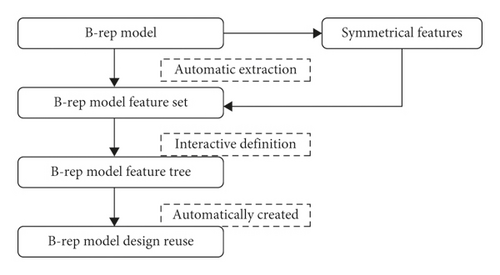
2.1. Symmetrical Characteristics of Modern Art Interaction
The symmetry feature of the modern art model is that the point group of a feature in the modern art model overlaps with the point group of other features through rotation, translation, and transformation. These two features are considered to be symmetrical.
2.2. Defining Interactively the Characteristics of Modern Art Interaction
Some artificial intelligence technologies can automatically identify features with symmetrical constraints, but for the features of other algorithms, it is difficult to automatically obtain satisfactory features from artificial intelligence technologies in current feature recognition methods, so traditional network computing methods in computational method are used to define other characteristics in artificial intelligence technology. All surface sets belonging to a feature are interactively selected, and the type of the feature is specified.
2.3. Automatically Create a Feature Tree for Modern Art Interaction
Before automatically creating the interactive feature tree of modern art, it is first necessary to preprocess the automatically recognized algorithm symmetry characteristics. The purpose of preprocessing is to reduce the number of feature sets when creating a feature tree by integrating feature sets with the same symmetric constraint relationship into new features and to facilitate the determination of the dependency relationship between feature sets. After obtaining the feature set of artificial intelligence technology, all the features of the algorithm directly or indirectly depend on the main shape feature of the algorithm. In the root nodes where the main feature of the algorithm is used as the root of the feature tree, the dependency relationship between features can be determined sequentially and recursively, and a feature tree of modern art interaction can be created based on the adjacent relationship between different feature groups.
3. Interactive Design of Artificial Intelligence and Modern Art
The interactive design of modern art incorporates knowledge from multiple fields. Both the expression of aesthetics and the logical thinking of philosophical concepts are included. Therefore, it is not only the artist’s process of artistic creation but also the entire process of their logical thinking. Therefore, on the basis of modern technological interaction, the interaction between art can be combined with artificial intelligence technology to generate a combination of artificial intelligence and modern art. Among them, the comparison between traditional art design and artificial intelligence technology is shown in Figure 2.
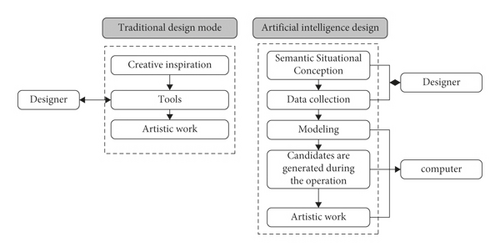
Due to the constraints of the parameters in the function, the input value of its variables is calculated according to the corresponding mapping principle of the function. The conversion is performed by setting the value of mapping fx. When the first mapping condition in the operation space is blank, then the output value of the function will all become 0, and when the content will not be blank, the output value is all 1. The corresponding sequence of fx can be quickly obtained.
Among them, x is the decision vector, ξ is the random vector parameter, η is the artificial intelligence technology vector parameter, f(x, ξ, n) is the objective function, and gj(x, ξ, n) is the constraint function. Due to the emergence of artificial intelligence technical parameters η and random parameters ξ, the symbols maxx and constraints in the model (1) lack clear meaning [5, 6]. In order to solve this problem, the artificial intelligence technology and random elements appearing in the model simultaneously are regarded as the coexistence of artificial intelligence technology and random chance for further consideration.
Among them, dij represents the distance between customer i and customer j.
Here, Q represents the concentration of the pheromone, which is a constant and affects the convergence speed of the algorithm. Lk represents the length of the art interaction path taken by this cycle for the k-th modern art interaction.
The use of artificial intelligence technology reflects the diversity, repetition, and spatiality in the interaction of multimedia elements. The method adopted is to first determine the target customers based on customer confidence and be able to take different interactive services according to different customers. Providing willful services to users is the purpose of interactive art, which can analyze and collect user information and establish a good interactive platform. Artificial intelligence technology shows the performance of hearing, tactile sensation, visual sense, and other functions in the interaction of multimedia elements, and these elements promote each other. Users are allowed to fully integrate into the multimedia interactive art, giving customers a strong visual impact. The common visual effects of visual pictures, the adjustment of screen colors, and the structure of characters are used in the artificial intelligence technology. It is a three-dimensional and multidimensional space where users feel the vision.
4. Application of Artificial Intelligence in Modern Art Interactive Design
4.1. Characteristics of Modern Art Graphics
4.1.1. Self-Similarity
Modern art graphics look very complicated, and the changes are variegated varied, but their integrity is not lost. The reason is the internal order within itself and seeking unity amidst changes [7]. There is a certain similarity between the part and the whole, and various parts of the modern art graphics, that is, it partially reflects the overall structural form and graphic style. This characteristic seeks for change in unity, maintains a unified form of beauty in the change, and also reflects the harmonious beauty of the whole and the part. This unique feature of self-similarity brings great charm to subtype graphics and can produce aesthetic pleasure when people watch them.
4.1.2. Infinite Scalability
The self-similarity of modern art graphics determines its infinite scalability. In other words, the modern art structure is embedded infinitely according to its own similarity. The reason why modern art patterns have a strong visual impact is that each part of the pattern is infinitely subdivided according to self-similarity. When the viewer is far-sighted, what he sees is an overall mobile beauty. If the viewer looks at it closely, he can see the visual beauty with rich details. This infinite nesting structure breaks the finiteness of the traditional aesthetic form of graphics and can extend infinitely, greatly enriching the structural form of graphics, making it always full of fantasy artistic charm, and providing new perspectives for the innovation of modern art graphics.
4.2. Color Judgment of Modern Art Graphics
A represents the threshold value obtained through experiments, and about 240 numerical values are set. Through b, the edge of the image can be maintained appropriately, and overdesign of the edge can be avoided. This time the background of the design is black, and the pixel value is black. (0,0,0), the color of the shaded part is usually close to white, but the pixel value is greater than any single color except white. Therefore, the state of the pixel value smaller than the color value is not changed, the pixel larger than the pixel value is converted into the background, and the target close to the white edge is maintained. Through color judgment, the undesigned image can be improved.
5. Application of Artificial Intelligence Technology in Modern Art Graphics
In the above expression, f represents the adaptive function corresponding to the feature vector χi of the feature data of modern art interactive design. γχi(g) represents the modern art interaction design analysis corresponding to the ε th design in the actual application process.
In the formula, πp and πq express the modern art interactive designs. If there is less information shared with the basic cluster of modern art interaction design, the accuracy of the basic cluster is low. Otherwise, it is vice versa.
In the formula, λ ∈ [0,1] the correctness and diversity of modern art interactive design are important degrees in the comprehensive evaluation criteria.
It is used to use roulette to randomly select an interactive design based on modern art and obtain modern art interactive design analysis. Scrambling rearranges the pixel positions of the image and only changes the correlation between adjacent pixels of each basic color image but cannot change the histogram of each basic color image. Or, by converting the pixel value of each basic color image, the overall histogram distribution characteristics of the basic color map can be changed. Therefore, if the pixel value is transformed after scrambling, better design security can be obtained.
In the formula, α ∈ [0,1], a system with uniform system parameters within this range has overall chaotic characteristics.
The weight of each loss item is determined after analyzing the results of 50 independent experiments.
Artificial intelligence technology no longer needs to specify this parameter. The algorithm dynamically adjusts appropriate parameter values based on the texture complexity of different regions of the image, and if the artificial intelligence technology maintains a constant speed, the superpixels produced are more neatly unified and help to reduce the influence of superpixel shape difference on the algorithm in the subsequent processing.
6. Artificial Intelligence and Generation of Artistic Inspiration
Artificial intelligence cannot achieve the best effect of art. The progress of art is the result of the progress of human thinking. Through continuous improvement, we continue to absorb the crystallization of experience. Computers are inherent thinking without the human subjective way of thinking. The original design of modern art is the feedback of people’s thoughts, activities, and experiences. Design is targeted innovative behavior using subjective analysis, and machines cannot think about problems independently, but they can also use empirical theories to perform artistic creation, with some simple creativity. It is just that the way it is formed has an artistic style, and the content is really fixed and repetitive.
Modern artists at home and abroad no longer use familiar patterns, expression subjects, and styles to attract people to love them [11, 12]. However, many innovations are quite the contrary. Therefore, in the interactive creation of modern art, we not only need to understand the purpose of artistic creation but also need artists to adjust independently according to the scenery.
6.1. Integration of Artificial Intelligence and Design Data
With the continuous improvement of the level of science and technology and the continuous development of Internet technology, it has been widely used in many fields. Security and data protection need to be increased for the modern art interactive design of large-scale data information on the Internet. However, modern art interaction has its own fragility, because the data information protection system has more hardware, and the shortcomings of software or data information security methods will cause major risks of security. If these vulnerabilities are used illegally, then modern art interaction will suffer a huge threat. Therefore, the research on modern art interaction has aroused the focus of researchers at home and abroad (Figure 3). In general, it is difficult to obtain satisfactory results by using the past data methods to solve the problem of data encryption and modern art interaction. With the usage of bionic intelligent algorithms on classic problems, it has a relatively global performance in the application. By means of the integrated design style, a page layout that humans love can be created according to the corresponding visual space configuration, color, design principles, and cognitive methods of the image.
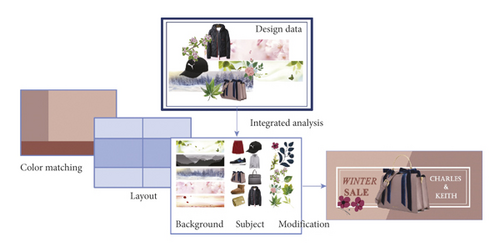
The information can be transmitted in a more diversified mode, and real-time interaction is enhanced. While improving the user experience, the interactive design of modern art is also more intelligent. As the basic conditions of artificial intelligence technology in modern art interactive design, artistic creation inspiration and data information integration can effectively combine the two key elements of color and style to illustrate the superiority of the combination of artificial intelligence in modern art interactive design [13].
7. Development Prospects of Artificial Intelligence in Modern Art Interactive Design
7.1. Collaborative Design under Complex and Diverse Data
One of the most significant features of the big data era is quantitative thinking, which can be fully quantified. Quantitative thinking comes from people’s desire for data analysis. There is still controversy about the quantification of artistic and cultural resources. However, as an interdisciplinary subject that integrates innovation and science, large and diverse data are used. The traditional design is obviously incapable of data processing. Meanwhile, a lot of repetition is also reflected in the traditional design process. The allocation rate of each working time of the designer in a day is shown in Figure 4. Repetitive and fixed operations in batches are important.
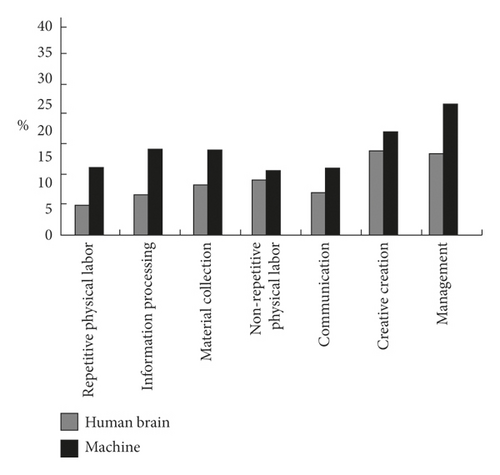
At the 2017 Design and Artificial Intelligence Conference, the relationship between future design and artificial intelligence was expressed by brain ratio (that is, the ratio of brain to machine). In the design work, the ratio of the human brain to the machine is shown in Figure 5. The involvement of a lot of work may be enhanced due to the participation of machines. The components involved in the human brain are getting smaller and smaller, and the degree of human participation is lower. Machines may replace part of human positions. For the design work, even if the participation of the machine increases, the participation of the human brain will only decrease, and it will even lead to the evolution or even the release of the human brain. Therefore, the design of the machine is included, more commonality of the machine and the human and the interaction between the machine and the human are expressed.
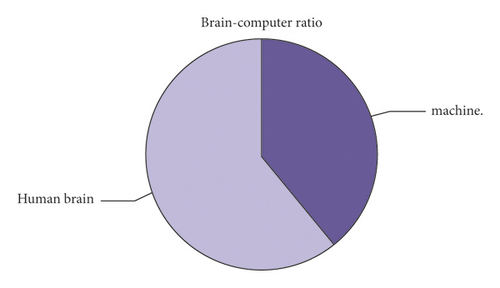
Efficiency is another important concern in thinking about big data. The design by the computer greatly shortens the life cycle of the product and greatly improves the production efficiency of the design. The efficiency problem caused by the influence of big data mainly means that the data update speed is fast and the update cycle is short. Fast food; demand means taking too much time. The consumption of energy is a problem disproportionate to demand. For example, posters and banners often used in the advertising industry and e-commerce do not need to be too exquisite. The demand needs to be expressed as much as possible through concise expression. In this case, training the computer to design smart posters can help designers deal with these high-speed design tasks.
7.2. Personalized Design under User Behavior Analysis
While molding the product image, design is also a process of satisfying the needs of users. Today’s society is rich in materials and increasingly mature in technology. The expectations and needs of the user community for the product have undergone great changes, from the traditional focus on the form, and gradually changed to be more concerned about its content and experience [14]. Therefore, the design point of view has also shifted from the traditional focus on the surface of things to compatibility and practicality.
The user’s needs are satisfied by the interaction between the user and the product, that is, the user’s subjective behavior. Traditional design often pays attention to the visual features, design concepts, and interaction methods of the product, while the modern design is not only a creative process. In addition, many extensible ingredients are added. The product demand difference between traditional design and modern design is shown in Figure 6. Designers, decision-makers, and manufacturers must pay more attention to actions and other information of users to improve design products. Temperature reflects the care for users, and the designed products are more targeted. In several designs facing a fixed group, there will be better practicability. The advantage of artificial intelligence is that it can perform intelligent analysis on large and regular data. In the past, questionnaire surveys were mainly used for the analysis of user. The artificial intelligence is introduced not only to reduce a large number of manual processing procedures but also to analyze and organize a large number of users’ action information and to make decisions, and then the user’s action information is added to the design, not just an increase in products. It can also bring more economic effects to human products.
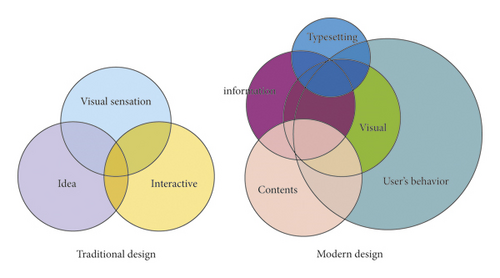
8. Examples and Results Analysis
Modern art interaction under artificial intelligence has become a future development trend. Traditional modern art interaction methods have been unable to meet people’s needs [15]. Based on artificial intelligence technology, this article designs modern art interactions for new media, improves the defects in traditional expressions, and verifies the effectiveness of the expression methods designed in this paper through experimental research and comparison.
The experimental environment is listed in Table 1.
| Item | Parameter |
|---|---|
| Programming language | C++ |
| Working time | 10 s |
| Times of experiments | 5 times |
| Operating system | Windows10 |
| Operation buses | RS485 |
| Operating platform | Man-machine interaction interface |
The design in this paper requires five steps: preprocessing, unification of concepts, user question processing, information extraction, and intelligent recognition to provide users with a multielement interactive art experience. The experimental process flow chart is shown in Figure 7.
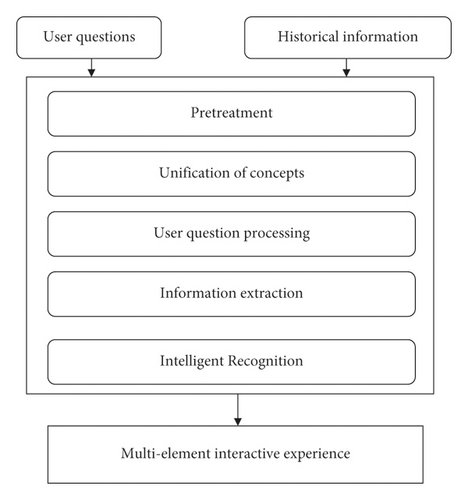
It can be concluded from Figure 8 that the main content to be done in the experimental preprocessing process is to perform statistics based on the data analysis that users like; meanwhile, it can meet the purpose of adjustment at any time. During this process, unified processing and interaction are mainly carried out in the expression style according to the complexity of the operation. The development of modern art interaction is promoted in the successive alternate process, which can effectively improve the accuracy and practicability of modern art creation. The extraction of modern art interaction information is mainly based on artificial intelligence technology to extract the parameters of modern art interaction information. Intelligent recognition brings a better experience for users to recognize the interactive needs of intelligent users, shorten the extraction time of interactive elements, and improve the flexible operation speed of interactive expressions. As shown in Figure 8, it is a modern art interactive information extraction diagram based on artificial intelligence technology.
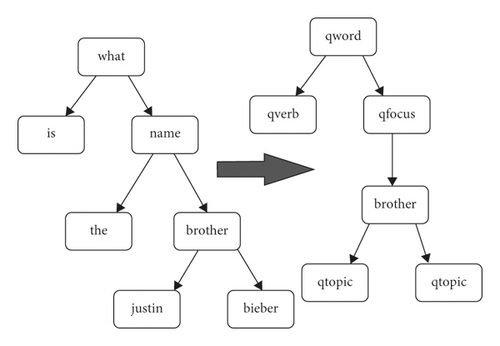
It can be seen from Table 2 that by comparing the features extracted by the three methods, it can achieve 100% variable data extraction during the first and fourth iterations. In other experimental processes, it is found that the extracted variables are higher than the algorithm. It shows that the algorithm proposed in this paper is faster than other algorithms in variable feature data speed.
| Iteration times | Network-manual coordination method (%) | Big data modern art interaction method (%) | Method proposed in this paper (%) |
|---|---|---|---|
| 1 | 64 | 54 | 100 |
| 2 | 61 | 61 | 98 |
| 3 | 61 | 64 | 98 |
| 4 | 63 | 62 | 100 |
| 5 | 100 | 62 | 98 |
| 6 | 96 | 70 | 98 |
| 7 | 95 | 58 | 98 |
The flexibility of the big data modern art interaction method, the network-artificial coordination modern art interaction method, and the modern art interaction method designed in this paper are compared, and the result is shown in Figure 9.
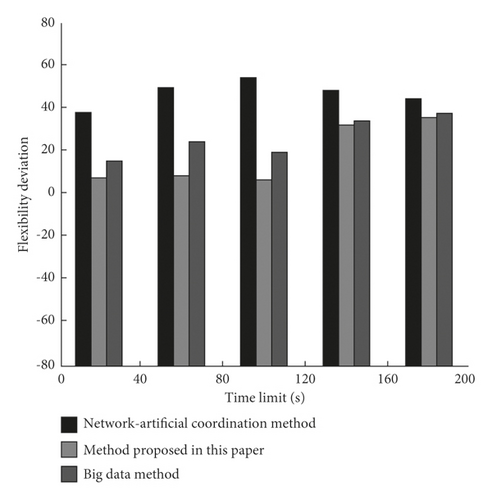
From the comparison result in Figure 9, it can be seen that the interactive design of modern art designed in this paper is more flexible. The topological calculation is adopted in this paper, which can reflect the expression of interactive art at any level based on artificial intelligence technology without being restricted by time and space. The interactive method of big data modern art and the interactive method of network-artificial coordination of modern art can only apply the corresponding interactive method of modern art at a specific time or place.
9. Conclusions
Artificial intelligence has introduced reforms in all walks of life. In the design industry, artificial intelligence can allow designers to reduce the tedious and complicated work to introduce some means of artistic expression of fixed machinery. A detailed analysis and summary of artificial intelligence technology and art are performed in this paper. Meanwhile, it is demonstrated based on real cases in practice, confirming that artificial intelligence technology can bring greater convenience to designers and the design industry, and reformative breakthroughs may occur to design methods. Technological reforms are also updates of method reforms. The innovative products of human-machine cooperation are worth looking forward to.
Conflicts of Interest
The author declares no conflicts of interest.
Acknowledgments
This study was sponsored by Xinxiang University.
Open Research
Data Availability
The labeled dataset used to support the findings of this study is available from the corresponding author upon request.




